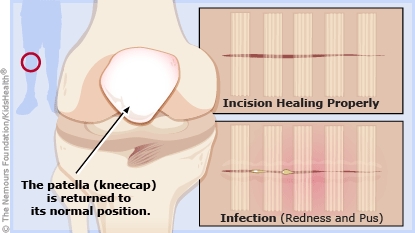A dislocated kneecap (patella) happens when the kneecap slides out of place. Your child had surgery so that the kneecap can stay in place. After a few months of rest and physical therapy, your child should be able to return to their normal activities.

Follow your health care provider's advice for:
- Giving your child any pain medicines. These may include prescription pain medicine, acetaminophen (Tylenol® or a store brand), or ibuprofen (Advil®, Motrin®, or a store brand). Some prescription pain medicines also include acetaminophen or ibuprofen. To avoid giving too much, give the medicines exactly as your health care provider recommends.
- When to remove the dressings and how to care for the surgical site.
- How to use the knee immobilizer and crutches.
- When it's OK for your child to shower (usually 2–3 days after surgery) and how long they need to keep the surgical site covered during showering.
- Any strengthening and stretching exercises your child should do.
- Going to see a physical therapist.
- When your child should follow up (usually in 2–3 days).
For swelling, your child should:
- Put ice wrapped in a towel on the knee for about 20 minutes several times a day. Do not put ice directly on the skin.
- Raise the knee above heart level when sitting or lying down.
If your child has swelling, numbness (loss of feeling), coldness, or tingling in the foot, loosen any bandages around the knee and raise the knee above heart level.
At the follow-up visit, your surgeon will talk to you about:
- How long your child needs to wear the immobilizer and use crutches.
- When your child can drive.
- When your child can go back to sports and whether they need to wear a brace or other supportive device on the knee while playing sports.

What happens during patellar dislocation surgery? The surgeon repairs damaged tissues around the kneecap and puts the kneecap in the right place by loosening, tightening, or moving some of the fibrous tissues that hold it in place. This stabilizes the knee to prevent future dislocations.




